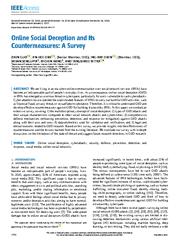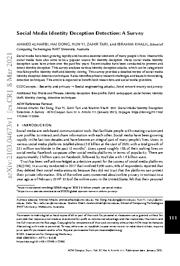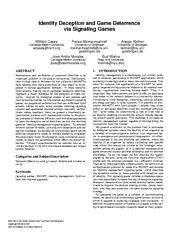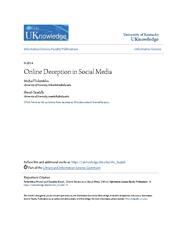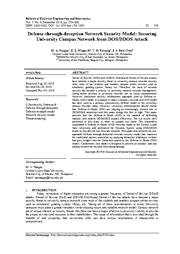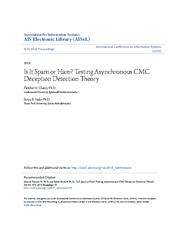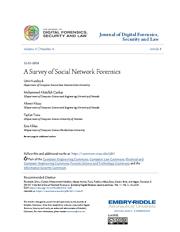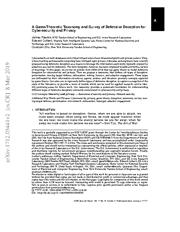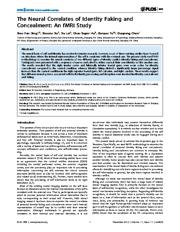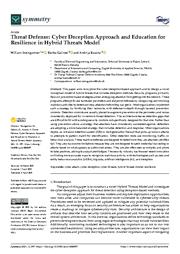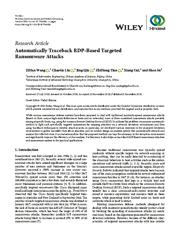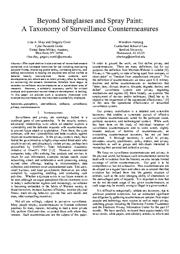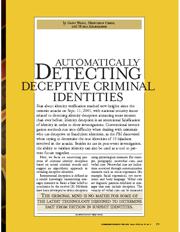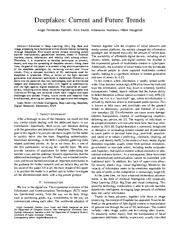A copy of this work was available on the public web and has been preserved in the Wayback Machine. The capture dates from 2021; you can also visit the original URL.
The file type is application/pdf.
Filters
Online Social Deception and Its Countermeasures: A Survey
2020
IEEE Access
and cybercrimes; 3) comprehensive defense mechanisms embracing prevention, detection, and response (or mitigation) against OSD attacks along with their pros and cons; 4) datasets/metrics used for validation ...
In this paper, we conduct an extensive survey, covering 1) the multidisciplinary concept of social deception; 2) types of OSD attacks and their unique characteristics compared to other social network attacks ...
Data in common contribution networks are used to establish a community's behavioral profile. ...
doi:10.1109/access.2020.3047337
fatcat:xw2rr2sjnrdf3nk4vfuowrkizy
Online Social Deception and Its Countermeasures for Trustworthy Cyberspace: A Survey
[article]
2020
arXiv
pre-print
In this paper, we conducted an extensive survey, covering (i) the multidisciplinary concepts of social deception; (ii) types of OSD attacks and their unique characteristics compared to other social network ...
used for validation and verification; and (v) legal and ethical concerns related to OSD research. ...
Data in common contribution networks are used to establish a community's behavioral profile. ...
arXiv:2004.07678v1
fatcat:k4a6siywefb6lhkmyn67lmoqwe
Social Media Identity Deception Detection: A Survey
[article]
2021
arXiv
pre-print
Recent studies have been conducted to prevent and detect identity deception. ...
Meanwhile, social media have also come to be a popular source for identity deception. Many social media identity deception cases have arisen over the past few years. ...
The proposed approach utilizes social network data and specifically a common contribution network. The social network formation bases on common contributions made by members. ...
arXiv:2103.04673v1
fatcat:zf6xcn3pafcgfbxmoewc3yhhpi
Identity Deception and Game Deterrence via Signaling Games
2016
Proceedings of the 9th EAI International Conference on Bio-inspired Information and Communications Technologies (formerly BIONETICS)
In these contexts, Sybil attacks, making use of replicated deceptive identities, represent a major challenge for the designers of these networks. ...
Maintenance and verification of persistent identities is an important problem in the area of networking. ...
possible with deceptive uses of identity. ...
doi:10.4108/eai.3-12-2015.2262519
dblp:journals/sesa/CaseyMKMM16
fatcat:6iy67ch34zhchaxhdxt5tu35pu
Online deception in social media
2014
Communications of the ACM
However, the emergence and use of this online environment has also created new opportunities for deception. ...
Furthermore, we explore some of the factors that can affect the difficulty in achieving deception in social media and we use a deception model to classify different online deception techniques. ...
We thank them for the opportunity they gave us to revise and strengthen this contribution. ...
doi:10.1145/2629612
fatcat:adjxd7jnmbgatjcrmupfworose
Defense-through-Deception Network Security Model: Securing University Campus Network from DOS/DDOS Attack
2018
Bulletin of Electrical Engineering and Informatics
Furthermore, this model is designed to prevent an attacker who has already entered the network from doing damage. ...
This paper also presents the new approach Defense-through-deception network security model that improves the traditional passive protection by applying deception techniques to them that give insights into ...
Using two way Anova with replication at 5 percent significance level, the data shows significant difference in the CPU utilization using different attacks. ...
doi:10.11591/eei.v7i4.1349
fatcat:zee7upg5bna55ks4g7elcwg5h4
Is It Spam or Ham? Testing Asynchronous CMC Deception Detection Theory
2010
International Conference on Information Systems
The e-mail was clustered using the text mining. The terms representing the clusters were analyzed using text analysis. ...
The contributions of this work are support for the ACDDT and a development of a new and unique method of detecting fraudulent e-mail. . ...
Examples of these words include unions, caucus, partner, comrade, friendship, teamwork, contribute, and network. ...
dblp:conf/icis/GlancyY10
fatcat:wgq74wvc6jgxpiu2wkutoqwhzu
A Survey of Social Network Forensics
2016
Journal of Digital Forensics, Security and Law
The data generated through the use of these technologies need to be analyzed for forensic purposes when criminal and terrorist activities are involved. ...
This will help digital forensics investigators to predict, detect and even prevent any criminal activities in different forms. ...
categorizes deception into category deception (gender switching), attractiveness deception, or identity concealment. ...
doi:10.15394/jdfsl.2016.1430
fatcat:wrlinyds4nf6zl7nybbyujqn64
A Game-Theoretic Taxonomy and Survey of Defensive Deception for Cybersecurity and Privacy
[article]
2019
arXiv
pre-print
In this paper, we survey 24 articles from 2008-2018 that use game theory to model defensive deception for cybersecurity and privacy. ...
Advocates and engineers have recently proposed using defensive deception as a means to leverage the information asymmetry typically enjoyed by attackers as a tool for defenders. ...
This is called obfuscation (Subsection 3.3). (4) Deception can use exchange systems such as mix networks and mix zones to prevent linkability. ...
arXiv:1712.05441v3
fatcat:baizt74d2fg37flf57u6e6i25q
The Neural Correlates of Identity Faking and Concealment: An fMRI Study
2012
PLoS ONE
The present study used fMRI methodology to examine the neural correlates of two different types of identity conflict: identity faking and concealment. ...
These results suggest that different neural systems associated with both identity processing and deception were involved in identity concealment and faking. ...
Author Contributions Conceived and designed the experiments: XPD GC GF. Performed the experiments: XPD XD DL. Analyzed the data: XPD XD. Contributed reagents/materials/analysis tools: XD DL CSH. ...
doi:10.1371/journal.pone.0048639
pmid:23144915
pmcid:PMC3492494
fatcat:nbgq7g5qcfcknjekrt6ntgq4pm
Threat Defense: Cyber Deception Approach and Education for Resilience in Hybrid Threats Model
2021
Symmetry
Security programs primarily focus on prevention-based strategies aimed at stopping attackers from getting into the network. ...
Most organizations implement such a strategy by fortifying their networks with defense-in-depth through layered prevention controls. ...
Deception for Identification and Prevention Other useful deception functionality includes being able to identify and prevent attacks. ...
doi:10.3390/sym13040597
fatcat:6thxnfbz4zf7jhi4lnenghqiqq
Automatically Traceback RDP-Based Targeted Ransomware Attacks
2018
Wireless Communications and Mobile Computing
considered ransomware attacks precisely aiming at specific hosts, e.g., using the common Remote Desktop Protocol (RDP). ...
To address this problem, we propose a systematic method to fight such specifically targeted ransomware by trapping attackers via a network deception environment and then using traceback techniques to identify ...
., using the common Remote Desktop Protocol (RDP). ...
doi:10.1155/2018/7943586
fatcat:qpy4tcwkafgjbbdxpetg7o3bl4
Beyond sunglasses and spray paint: A taxonomy of surveillance countermeasures
2013
2013 IEEE International Symposium on Technology and Society (ISTAS): Social Implications of Wearable Computing and Augmediated Reality in Everyday Life
web browsers; enact Do Not Track policy [103, 104] Prevent Data Collection Organizational policy that prohibits data collection; system architecture that does not collect data; avoid collecting sensitive ...
[107] Sneaker Net Employ human or animal couriers; communicate via paper and pen Spoof Network Identity Spoof IP or MAC address [108] System Analyze System ...
Data Access Prevent or disrupt access to data, possibly by disrupting the sensor network itself. ...
doi:10.1109/istas.2013.6613118
dblp:conf/istas/ShayCH13
fatcat:yfm6jzplg5bmbn5u7krgcglisy
Automatically detecting deceptive criminal identities
2004
Communications of the ACM
Besides its use in post-event investigation, the ability to validate identity can also be used as a tool to prevent future tragedies. ...
Second, crime analysts can detect some deceptive identities through crime analysis techniques, of which link analysis is often used to construct criminal networks from database records or textual documents ...
doi:10.1145/971617.971618
fatcat:znuvx4p2tzgd7ob22m7hyimy4y
Deepfakes: Current and Future Trends
2022
Zenodo
Therefore, it is imperative to develop techniques to prevent, detect, and stop the spreading of deepfake content. ...
Advances in Deep Learning (DL), Big Data and image processing have facilitated online disinformation spreading through Deepfakes. ...
Regarding detection, approaches based on Convolutional Neural Networks (CNNs) are the most common strategy, due to the nature of the used data, i.e., image and video. ...
doi:10.5281/zenodo.7429907
fatcat:36o7kq3qevhz5dmyufxaqhkepe
« Previous
Showing results 1 — 15 out of 23,377 results

